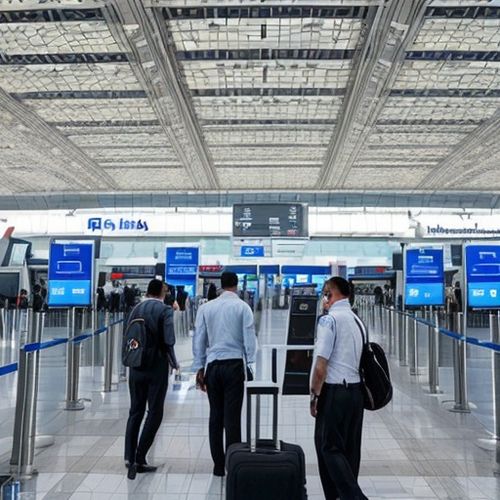The recent introduction of AI-powered immigration clearance at Dubai International Airport, boasting an astonishing processing time of just 12 seconds per passenger, has sent ripples through the global travel industry. This groundbreaking system, which combines facial recognition and advanced algorithms to verify travelers' identities without human intervention, represents a quantum leap in border control technology. As Dubai solidifies its reputation as a hub for technological innovation, aviation experts and government officials worldwide are now grappling with a critical question: could this become the new global standard for international travel?
Dubai's AI clearance system works by capturing high-resolution images of passengers as they approach designated e-gates. The technology cross-references these images with passport databases and INTERPOL watchlists in real-time, while simultaneously analyzing behavioral patterns for potential security risks. What makes this system revolutionary isn't just its speed—traditional passport control typically takes 45 seconds to several minutes per passenger—but its ability to maintain near-perfect accuracy rates while handling the airport's massive daily throughput of over 250,000 travelers.
The implications for global aviation are profound. Major international hubs like Heathrow, JFK, and Changi have been investing heavily in biometric systems, but none have achieved Dubai's seamless integration of multiple security checks into a single instantaneous process. Industry analysts suggest that the 12-second benchmark sets an unprecedented expectation for traveler convenience, potentially reshaping passenger expectations at every international border crossing point.
However, the path to worldwide adoption faces significant hurdles. Data privacy concerns top the list, particularly in regions with strict personal information protection laws like the European Union. The General Data Protection Regulation (GDPR) imposes stringent requirements on biometric data collection that may complicate implementation. Additionally, the system's reliance on high-quality passport photos and advanced camera infrastructure could prove cost-prohibitive for smaller nations or airports with limited budgets.
Cultural resistance to surveillance technologies presents another barrier. While passengers in tech-forward societies like the UAE and Singapore readily embrace facial recognition, other populations may view such systems as overly intrusive. Recent protests against biometric data collection in several European cities suggest that public acceptance isn't guaranteed, regardless of the promised convenience benefits.
The technology also raises complex questions about equity in global travel. Dubai's system works flawlessly for passengers with up-to-date biometric passports from technologically advanced nations. But travelers from developing countries or those with older travel documents might find themselves funneled into slower manual processing lanes, potentially creating a two-tiered system that privileges certain nationalities over others.
From an operational perspective, airports would need to undergo massive infrastructure overhauls to implement similar systems. The current generation of e-gates in most international airports can't support the advanced AI processing required for 12-second clearances. Retrofitting existing facilities while maintaining continuous border control operations presents logistical nightmares that could take years and billions of dollars to resolve globally.
Despite these challenges, the economic incentives for adoption are compelling. Dubai Airports CEO Paul Griffiths estimates that reducing average processing times from minutes to seconds could increase terminal capacity by 15-20% without physical expansion—a crucial advantage for space-constrained hubs. The potential to reallocate border control staff to higher-value security tasks presents additional operational efficiencies that cash-strapped aviation authorities find increasingly attractive.
The COVID-19 pandemic accelerated contactless technology adoption across airports worldwide, creating fertile ground for Dubai's innovation to spread. Health concerns made passengers more willing to embrace biometric solutions that minimize surface contact and human interaction. This shift in traveler psychology, combined with post-pandemic labor shortages in immigration services, has created unprecedented openness to automated border solutions among both airports and governments.
Looking ahead, industry observers predict a phased global rollout rather than immediate universal adoption. Wealthy nations with tech-savvy populations and security-focused governments—think Singapore, South Korea, Israel, and possibly the UK—will likely implement similar systems within 3-5 years. The U.S. may follow selectively at major international gateways, while the EU's more cautious approach could see member states adopting varying versions with enhanced privacy safeguards.
Developing nations face a tougher path. Without significant international funding or technology transfers, many may struggle to implement such advanced systems before 2030. This technological divide could inadvertently reshape global travel patterns, with passengers potentially favoring routes through airports offering seamless transit experiences—a development that would further concentrate traffic at already dominant hubs like Dubai.
The human element of border control shouldn't be overlooked in this technological revolution. While AI can handle routine verifications with superhuman speed, experienced immigration officers bring nuanced judgment for complex cases—from identifying potential trafficking victims to spotting behavioral red flags that algorithms might miss. The most likely future scenario involves hybrid systems where AI handles the majority of straightforward cases while humans focus on exceptions and high-risk scenarios.
As the travel industry emerges from its pandemic slump, Dubai's 12-second miracle offers both inspiration and challenges for airports worldwide. The coming decade will likely see a patchwork of implementations as nations balance security, privacy, efficiency, and passenger experience in their unique contexts. One thing appears certain: the 45-minute immigration queues that plague many international arrivals halls may soon become relics of a bygone era, thanks to a quiet revolution started in the deserts of the UAE.

By Lily Simpson/Apr 7, 2025

By Samuel Cooper/Apr 7, 2025

By Rebecca Stewart/Apr 7, 2025

By Sarah Davis/Apr 7, 2025

By Rebecca Stewart/Apr 7, 2025

By Amanda Phillips/Apr 7, 2025

By Natalie Campbell/Apr 7, 2025

By Jessica Lee/Apr 7, 2025

By Thomas Roberts/Apr 7, 2025

By Daniel Scott/Apr 7, 2025

By Emily Johnson/Apr 7, 2025

By Victoria Gonzalez/Apr 7, 2025

By George Bailey/Apr 7, 2025

By Rebecca Stewart/Apr 7, 2025

By Elizabeth Taylor/Apr 7, 2025

By Thomas Roberts/Apr 7, 2025

By Lily Simpson/Apr 7, 2025